Cat
From Wikipedia, the free encyclopedia
This article is about the cat species that is commonly kept as a pet. For the cat family, see Felidae. For other uses, see Cat (disambiguation) and Cats (disambiguation).
| Domestic cat[1] | |
|---|---|
 |
|
| Six breeds of cat | |
|
Domesticated
|
|
| Scientific classification | |
| Kingdom: | Animalia |
| Phylum: | Chordata |
| Class: | Mammalia |
| Order: | Carnivora |
| Suborder: | Feliformia |
| Family: | Felidae |
| Subfamily: | Felinae |
| Genus: | Felis |
| Species: | F. catus |
| Binomial name | |
| Felis catus[2] Linnaeus, 1758[3] |
|
| Synonyms | |
|
Felis silvestris catus (subjective synonym)[4] Felis catus domestica (invalid junior synonym)[5] |
|
Cats are similar in anatomy to the other felids, with strong, flexible bodies, quick reflexes, sharp retractable claws, and teeth adapted to killing small prey. Cat senses fit a crepuscular and predatory ecological niche. Cats can hear sounds too faint or too high in frequency for human ears, such as those made by mice and other small animals. They can see in near darkness. Like most other mammals, cats have poorer color vision and a better sense of smell than humans.
Despite being solitary hunters, cats are a social species and cat communication includes the use of a variety of vocalizations (mewing, purring, trilling, hissing, growling and grunting), as well as cat pheromones and types of cat-specific body language.[7]
Cats have a high breeding rate. Under controlled breeding, they can be bred and shown as registered pedigree pets, a hobby known as cat fancy. Failure to control the breeding of pet cats by neutering and the abandonment of former household pets has resulted in large numbers of feral cats worldwide, requiring population control.[8] This has contributed, along with habitat destruction and other factors, to extinction of many bird species. Cats have been known to extirpate a bird species within a specific region and may have contributed to extinction of isolated island populations.[9] Cats are thought to be primarily, though not solely responsible, for the extinction of 33 species of birds and the presence of feral and free ranging cats makes some locations unsuitable for attempted species reestablishment in otherwise suitable locations.[10]
Since cats were venerated in ancient Egypt, they were commonly believed to have been domesticated there,[11] but there may have been instances of domestication as early as the Neolithic from around 9,500 years ago (7,500 BC).[12] A genetic study in 2007 concluded that domestic cats are descended from African wildcats (Felis silvestris lybica), having diverged around 8,000 BC in West Asia.[11][13] Cats are the most popular pet in the world, and are now found in almost every place where humans live.[14]
Contents
Nomenclature and etymology
The English word 'cat' (Old English catt) is in origin a loanword, introduced to many languages of Europe from Latin cattus[15] and Byzantine Greek κάττα, including Portuguese and Spanish gato, French chat, German Katze, Lithuanian katė and Old Church Slavonic kotka, among others.[16] The ultimate source of the word is Afroasiatic, presumably from Late Egyptian čaute,[17] the feminine of čaus "wildcat". The word was introduced, together with the domestic animal itself, to the Roman Republic by the first century BC.[citation needed] An alternative word with cognates in many languages is English 'puss' ('pussycat'). Attested only from the 16th century, it may have been introduced from Dutch poes or from Low German puuskatte, related to Swedish kattepus, or Norwegian pus, pusekatt. Similar forms exist in Lithuanian puižė and Irish puiscín. The etymology of this word is unknown, but it may have simply arisen from a sound used to attract a cat.[18][19]A group of cats is referred to as a "clowder" or a "glaring",[20] a male cat is called a "tom" or "tomcat"[21] (or a "gib",[22] if neutered), an unaltered female is called a "queen",[23] and a prepubescent juvenile is referred to as a "kitten". Although spayed females have no commonly used name, in some rare instances, an immature or spayed female is referred to as a "molly".[citation needed] The male progenitor of a cat, especially a pedigreed cat, is its "sire",[24] and its female progenitor is its "dam".[25] In Early Modern English, the word 'kitten' was interchangeable with the now-obsolete word 'catling'.[26]
A pedigreed cat is one whose ancestry is recorded by a cat fancier organization. A purebred cat is one whose ancestry contains only individuals of the same breed. Many pedigreed and especially purebred cats are exhibited as show cats. Cats of unrecorded, mixed ancestry are referred to as domestic short-haired or domestic long-haired cats, by coat type, or commonly as random-bred, moggies (chiefly British), or (using terms borrowed from dog breeding) mongrels or mutt-cats.
While the African wildcat is the ancestral subspecies from which domestic cats are descended, and wildcats and domestic cats can completely interbreed, several intermediate stages occur between domestic pet and pedigree cats on one hand and those entirely wild animals on the other. The semiferal cat, a mostly outdoor cat, is not owned by any one individual, but is generally friendly to people and may be fed by several households. Feral cats are associated with human habitation areas and may be fed by people or forage in rubbish, but are typically wary of human interaction.[27]
Taxonomy and evolution
Main article: Cat evolution
The African wildcat, Felis silvestris lybica, is the ancestor of the domestic cat.
The domestic cat was first classified as Felis catus by Carolus Linnaeus in the 10th edition of his Systema Naturae published in 1758.[1][3] Because of modern phylogenetics, domestic cats are usually regarded as another subspecies of the wildcat, F. silvestris.[1][4][31] This has resulted in mixed usage of the terms, as the domestic cat can be called by its subspecies name, Felis silvestris catus.[1][4][31] Wildcats have also been referred to as various subspecies of F. catus,[31] but in 2003, the International Commission on Zoological Nomenclature fixed the name for wildcats as F. silvestris.[32] The most common name in use for the domestic cat remains F. catus, following a convention for domesticated animals of using the earliest (the senior) synonym proposed.[32] Sometimes, the domestic cat has been called Felis domesticus[33] or Felis domestica,[1] as proposed by German naturalist J. C. P. Erxleben in 1777 but these are not valid taxonomic names and have been used only rarely in scientific literature,[34] because Linnaeus's binomial takes precedence.[35] A population of Transcaucasian black feral cats was once classified as Felis daemon (Satunin 1904) but now this population is considered to be a part of domestic cat.[36]
All the cats in this genus share a common ancestor that probably lived around 6–7 million years ago in Asia.[37] The exact relationships within the Felidae are close but still uncertain,[38][39] e.g. the Chinese mountain cat is sometimes classified (under the name Felis silvestris bieti) as a subspecies of the wildcat, like the North African variety F. s. lybica.[4][38]
In comparison to dogs, cats have not undergone major changes during the domestication process, as the form and behavior of the domestic cat is not radically different from those of wildcats and domestic cats are perfectly capable of surviving in the wild.[40][41] Fully domesticated house cats often interbreed with feral F. catus populations.[27] This limited evolution during domestication, means that hybridisation can occur with many other felids notably the Asian leopard cat.[42] Several natural behaviors and characteristics of wildcats may have preadapted them for domestication as pets.[41] These traits include their small size, social nature, obvious body language, love of play and relatively high intelligence;[43]:12–17 they may also have an inborn tendency towards tameness.[41]
Cats have either a mutualistic or commensal relationship with humans. Two main theories are given about how cats were domesticated. In one, people deliberately tamed cats in a process of artificial selection, as they were useful predators of vermin.[44] This has been criticized as implausible, because the reward for such an effort may have been too little; cats generally do not carry out commands and although they do eat rodents, other species such as ferrets or terriers may be better at controlling these pests.[4] The alternative idea is that cats were simply tolerated by people and gradually diverged from their wild relatives through natural selection, as they adapted to hunting the vermin found around humans in towns and villages.[4]
Genetics
Main article: Cat genetics
The domesticated cat and its closest wild ancestor are both diploid organisms that possess 38 chromosomes[45] and roughly 20,000 genes.[46] About 250 heritable genetic disorders have been identified in cats, many similar to human inborn errors.[47] The high level of similarity among the metabolism of mammals allows many of these feline diseases to be diagnosed using genetic tests that were originally developed for use in humans, as well as the use of cats as animal models in the study of the human diseases.[48][49]Anatomy
Main article: Cat anatomy
Diagram of the general anatomy of a male
Cats have seven cervical vertebrae, as do almost all mammals; 13 thoracic vertebrae (humans have 12); seven lumbar vertebrae (humans have five); three sacral vertebrae like most mammals (humans have five); and a variable number of caudal vertebrae in the tail (humans retain three to five caudal vertebrae, fused into an internal coccyx).[54]:11 The extra lumbar and thoracic vertebrae account for the cat's spinal mobility and flexibility. Attached to the spine are 13 ribs, the shoulder, and the pelvis.[54] :16 Unlike human arms, cat forelimbs are attached to the shoulder by free-floating clavicle bones which allow them to pass their bodies through any space into which they can fit their heads.[55]
Cat skull
Cats, like dogs, are digitigrades. They walk directly on their toes, with the bones of their feet making up the lower part of the visible leg.[58] Cats are capable of walking very precisely, because like all felines, they directly register; that is, they place each hind paw (almost) directly in the print of the corresponding fore paw, minimizing noise and visible tracks. This also provides sure footing for their hind paws when they navigate rough terrain. Unlike most mammals, when cats walk, they use a "pacing" gait; that is, they move the two legs on one side of the body before the legs on the other side. This trait is shared with camels and giraffes. As a walk speeds up into a trot, a cat's gait changes to be a "diagonal" gait, similar to that of most other mammals (and many other land animals, such as lizards): the diagonally opposite hind and fore legs move simultaneously.[59]
Like almost all members of the Felidae, cats have protractable and retractable claws.[60] In their normal, relaxed position, the claws are sheathed with the skin and fur around the paw's toe pads. This keeps the claws sharp by preventing wear from contact with the ground and allows the silent stalking of prey. The claws on the fore feet are typically sharper than those on the hind feet.[61] Cats can voluntarily extend their claws on one or more paws. They may extend their claws in hunting or self-defense, climbing, kneading, or for extra traction on soft surfaces. Most cats have five claws on their front paws, and four on their rear paws.[62] The fifth front claw (the dewclaw) is proximal to the other claws. More proximally is a protrusion which appears to be a sixth "finger". This special feature of the front paws, on the inside of the wrists, is the carpal pad, also found on the paws of big cats and of dogs. It has no function in normal walking, but is thought to be an antiskidding device used while jumping. Some breeds of cats are prone to polydactyly (extra toes and claws).[62] These are particularly common along the northeast coast of North America.[63]
Physiology
| Body temperature | 38.6 °C (101.5 °F) |
| Heart rate | 120–140 beats per minute |
| Breathing rate | 16–40 breaths per minute |
Thermograph
Cats conserve heat by reducing the flow of blood to their skin and lose heat by evaporation through their mouths. Cats have minimal ability to sweat, with glands located primarily in their paw pads,[66] and pant for heat relief only at very high temperatures[67] (but may also pant when stressed). A cat's body temperature does not vary throughout the day; this is part of cats' general lack of circadian rhythms and may reflect their tendency to be active both during the day and at night.[68]:1 Cats' feces are comparatively dry and their urine is highly concentrated, both of which are adaptations to allow cats to retain as much water as possible.[33] Their kidneys are so efficient, they can survive on a diet consisting only of meat, with no additional water,[69] and can even rehydrate by drinking seawater.[68]:29[70]
Cats are obligate carnivores: their physiology has evolved to efficiently process meat, and they have difficulty digesting plant matter.[33] In contrast to omnivores such as rats, which only require about 4% protein in their diet, about 20% of a cat's diet must be protein.[33] Cats are unusually dependent on a constant supply of the amino acid arginine, and a diet lacking arginine causes marked weight loss and can be rapidly fatal.[71] Another unusual feature is that the cat cannot produce taurine, with taurine deficiency causing macular degeneration, wherein the cat's retina slowly degenerates, causing irreversible blindness.[33] Since cats tend to eat all of their prey, they obtain minerals by digesting animal bones, and a diet composed only of meat may cause calcium deficiency.[33]
A cat's gastrointestinal tract is adapted to meat eating, being much shorter than that of omnivores and having low levels of several of the digestive enzymes needed to digest carbohydrates.[72] These traits severely limit the cat's ability to digest and use plant-derived nutrients, as well as certain fatty acids.[72] Despite the cat's meat-oriented physiology, several vegetarian or vegan cat foods have been marketed that are supplemented with chemically synthesized taurine and other nutrients, in attempts to produce a complete diet. However, some of these products still fail to provide all the nutrients cats require,[73] and diets containing no animal products pose the risk of causing severe nutritional deficiencies.[74]
Cats do eat grass occasionally. A proposed explanation is that cats use grass as a source of folic acid. Another proposed explanation is that it is used to supply dietary fiber.[75]
Senses
Main article: Cat senses
Reflection of camera flash from the tapetum lucidum
Cats have excellent hearing and can detect an extremely broad range of frequencies. They can hear higher-pitched sounds than either dogs or humans, detecting frequencies from 55 Hz to 79,000 Hz, a range of 10.5 octaves, while humans and dogs both have ranges of about 9 octaves.[81][82] Cats can hear ultrasound, which is important in hunting [83] because many species of rodents make ultrasonic calls.[84] However, they do not communicate using ultrasound like rodents do. Cats' hearing is also sensitive and among the best of any mammal,[81] being most acute in the range of 500 Hz to 32 kHz.[85] This sensitivity is further enhanced by the cat's large movable outer ears (their pinnae), which both amplify sounds and help detect the direction of a noise.[83]
Cats' whiskers are highly sensitive to touch.
Cats have relatively few taste buds compared to humans. Domestic and wild cats share a gene mutation that keeps their sweet taste buds from binding to sugary molecules, leaving them with no ability to taste sweetness.[92] Their taste buds instead respond to amino acids, bitter tastes, and acids.[93]
To aid with navigation and sensation, cats have dozens of movable whiskers (vibrissae) over their bodies, especially their faces. These provide information on the width of gaps and on the location of objects in the dark, both by touching objects directly and by sensing air currents; they also trigger protective blink reflexes to protect the eyes from damage.[56]:47
Health
Main article: Cat health
The average lifespan of pet cats has risen in recent years. In the early 1980s it was about seven years,[94]:33[95] rising to 9.4 years in 1995[94]:33 and 12–15 years in 2014.[96] However, cats have been reported as surviving into their 30s,[97] with the oldest known cat, Creme Puff, dying at a verified age of 38.[98]Spaying or neutering increases life expectancy: one study found neutered male cats live twice as long as intact males, while spayed female cats live 62% longer than intact females.[94]:35 Non-neutered cats in the U.S. are four times as likely to be hit by a car as a neutered cat, and are three times more likely to require treatment for an animal bite.[99] Having a cat neutered confers health benefits, because castrated males cannot develop testicular cancer, spayed females cannot develop uterine or ovarian cancer, and both have a reduced risk of mammary cancer.[100]
Despite widespread concern about the welfare of free-roaming cats, the lifespans of neutered feral cats in managed colonies compare favourably with those of pet cats.[101]:45[102]:1358 Neutered cats in managed colonies can also live long lives.[103][104][105][106]
Diseases
Cats can suffer from a wide range of health problems, including infectious diseases, parasites, injuries, and chronic disease. Vaccinations are available for many of these diseases, and domestic cats are regularly given treatments to eliminate parasites such as worms and fleas.Poisoning
In addition to obvious dangers such as rodenticides, insecticides, and herbicides, cats may be poisoned by many chemicals usually considered safe by their human guardians,[107] because their livers are less effective at some forms of detoxification than those of many other animals, including humans and dogs.[33][108] Some of the most common causes of poisoning in cats are antifreeze and rodent baits.[109] Cats may be particularly sensitive to environmental pollutants.[107][110] When a cat has a sudden or prolonged serious illness without any obvious cause, it has possibly been exposed to a toxin.Many human medicines should never be given to cats. For example, the painkiller paracetamol (or acetaminophen, sold as Tylenol and Panadol) is extremely toxic to cats: even very small doses need immediate treatment and can be fatal.[111][112] Even aspirin, which is sometimes used to treat arthritis in cats, is much more toxic to them than to humans[112] and must be administered cautiously.[107] Similarly, application of minoxidil (Rogaine) to the skin of cats, either accidentally or by well-meaning guardians attempting to counter loss of fur, has sometimes been fatal.[113] Essential oils can be toxic to cats and cases have been reported of serious illnesses caused by tea tree oil, including flea treatments and shampoos containing it.[114]
Other common household substances that should be used with caution around cats include mothballs and other naphthalene products.[107] Phenol-based products (e.g. Pine-Sol, Dettol (Lysol) or hexachlorophene)[107] are often used for cleaning and disinfecting near cats' feeding areas or litter boxes, but these can sometimes be fatal.[115] Ethylene glycol, often used as an automotive antifreeze, is particularly appealing to cats, and as little as a teaspoonful can be fatal.[116] Some human foods are toxic to cats; for example chocolate can cause theobromine poisoning, although (unlike dogs) few cats will eat chocolate.[117] Large amounts of onions or garlic are also poisonous to cats.[107] Many houseplants are also dangerous,[118] such as Philodendron species and the leaves of the Easter lily (Lilium longiflorum), which can cause permanent and life-threatening kidney damage.[119]
Behavior
Free-ranging cats are active both day and night, although they tend to be slightly more active at night.[120][121] The timing of cats' activity is quite flexible and varied, which means house cats may be more active in the morning and evening (crepuscular behavior), as a response to greater human activity at these times.[122] Although they spend the majority of their time in the vicinity of their home, housecats can range many hundreds of meters from this central point, and are known to establish territories that vary considerably in size, in one study ranging from 7 to 28 hectares (17–69 acres).[121]Cats conserve energy by sleeping more than most animals, especially as they grow older. The daily duration of sleep varies, usually 12–16 hours, with 13–14 being the average. Some cats can sleep as much as 20 hours in a 24-hour period. The term "cat nap" for a short rest refers to the cat's tendency to fall asleep (lightly) for a brief period. While asleep, cats experience short periods of rapid eye movement sleep often accompanied by muscle twitches, which suggests they are dreaming.[123]
Sociability
Although wildcats are solitary, the social behavior of domestic cats is much more variable and ranges from widely dispersed individuals to feral cat colonies that form around a food source, based on groups of co-operating females.[124][125] Within such groups, one cat is usually dominant over the others.[34] Each cat in a colony holds a distinct territory, with sexually active males having the largest territories, which are about 10 times larger than those of female cats and may overlap with several females' territories.[88] These territories are marked by urine spraying, by rubbing objects at head height with secretions from facial glands, and by defecation.[88] Between these territories are neutral areas where cats watch and greet one another without territorial conflicts. Outside these neutral areas, territory holders usually chase away stranger cats, at first by staring, hissing, and growling, and if that does not work, by short but noisy and violent attacks. Despite some cats cohabiting in colonies, they do not have a social survival strategy, or a pack mentality, and always hunt alone.[126]Domestic cats use many vocalizations for communication, including purring, trilling, hissing, growling/snarling, grunting, and several different forms of meowing.[7] By contrast, feral cats are generally silent.[127]:208 Their types of body language, including position of ears and tail, relaxation of whole body, and kneading of paws, are all indicators of mood. The tail and ears are particularly important social signal mechanisms in cats,[128][129] e.g. with a raised tail acting as a friendly greeting, and flattened ears indicating hostility. Tail-raising also indicates the cat's position in the group's social hierarchy, with dominant individuals raising their tails less often than subordinate animals.[129] Nose-to-nose touching is also a common greeting and may be followed by social grooming, which is solicited by one of the cats raising and tilting its head.[125]
Cat with an Alaskan Malamute dog
Though cats and dogs are believed to be natural enemies, they can live together if correctly socialized.[131]
Life in proximity to humans and other domestic animals has led to a symbiotic social adaptation in cats, and cats may express great affection toward humans or other animals. Ethologically, the human keeper of a cat may function as a sort of surrogate for the cat's mother,[citation needed] and adult housecats live their lives in a kind of extended kittenhood,[132] a form of behavioral neoteny. The high-pitched sounds housecats make to solicit food may mimic the cries of a hungry human infant, making them particularly hard for humans to ignore.[133]
Grooming
The hooked papillae on a cat's tongue act like a hairbrush to help clean and detangle fur.
Fighting
Among domestic cats, males are more likely to fight than females.[137] Among feral cats, the most common reason for cat fighting is competition between two males to mate with a female. In such cases, most fights are won by the heavier male.[138] Another common reason for fighting in domestic cats is the difficulty of establishing territories within a small home.[137] Female cats also fight over territory or to defend their kittens. Neutering will decrease or eliminate this behavior in many cases, suggesting that the behavior is linked to sex hormones.[citation needed]
Indicating aggression
Serious damage is rare, as the fights are usually short in duration, with the loser running away with little more than a few scratches to the face and ears. However, fights for mating rights are typically more severe and injuries may include deep puncture wounds and lacerations. Normally, serious injuries from fighting are limited to infections of scratches and bites, though these can occasionally kill cats if untreated. In addition, bites are probably the main route of transmission of feline immunodeficiency virus.[140] Sexually active males are usually involved in many fights during their lives, and often have decidedly battered faces with obvious scars and cuts to their ears and noses.
Hunting and feeding
A cat that has caught a mouse
Free-fed feral cats and house cats tend to consume many small meals in a single day, although the frequency and size of meals varies between individuals.[126] Cats use two hunting strategies, either stalking prey actively, or waiting in ambush until an animal comes close enough to be captured. Although it is not certain, the strategy used may depend on the prey species in the area, with cats waiting in ambush outside burrows, but tending to actively stalk birds.[146]:153
Most breeds of cat have a noted fondness for settling in high places, or perching. In the wild, a higher place may serve as a concealed site from which to hunt; domestic cats may strike prey by pouncing from a perch such as a tree branch, as does a leopard.[147][clarification needed] Another possible explanation is that height gives the cat a better observation point, allowing it to survey its territory. During a fall from a high place, a cat can reflexively twist its body and right itself using its acute sense of balance and flexibility.[148][clarification needed] This is known as the cat righting reflex. An individual cat always rights itself in the same way, provided it has the time to do so, during a fall. The height required for this to occur is around 90 cm (3 ft). Cats without a tail (e.g. Manx cats) also have this ability, since a cat mostly moves its hind legs and relies on conservation of angular momentum to set up for landing, and the tail is little used for this feat.[149]
The perhaps best known element of cats' hunting behavior, which is commonly misunderstood and often appalls cat owners because it looks like torture, is that cats often appear to "play" with prey by releasing it after capture. This behavior is due to an instinctive imperative to ensure that the prey is weak enough to be killed without endangering the cat.[150] This behavior is referred to in the idiom "cat-and-mouse game" or simply "cat and mouse".
Another poorly understood element of cat hunting behavior is the presentation of prey to human guardians. Ethologist Paul Leyhausen proposed that cats adopt humans into their social group and share excess kill with others in the group according to the dominance hierarchy, in which humans are reacted to as if they are at, or near, the top.[151] Anthropologist and zoologist Desmond Morris, in his 1986 book Catwatching, suggests, when cats bring home mice or birds, they are attempting to teach their human to hunt, or trying to help their human as if feeding "an elderly cat, or an inept kitten".[152][153] Morris's theory is inconsistent with the fact that male cats also bring home prey, despite males having no involvement with raising kittens.[146]:153
Domestic cats select food based on its temperature, smell, and texture, strongly disliking chilled foods and responding most strongly to moist foods rich in amino acids, which are similar to meat.[74][126] Cats may reject novel flavors (a response termed neophobia) and learn quickly to avoid foods that have tasted unpleasant in the past.[126] They may also avoid sugary foods and milk; since they are lactose intolerant, these sugars are not easily digested and may cause soft stools or diarrhea.[126][154] They can also develop odd eating habits. Some cats like to eat or chew on other things, most commonly wool, but also plastic, cables, paper, string, aluminum foil/Christmas tree tinsel, or even coal. This condition, pica, can threaten their health, depending on the amount and toxicity of the items eaten.[155][156]
Though cats usually prey on animals more than half their size, a feral cat in Australia had been photographed to kill an adult pademelon weighing around the cat's size at 4 kg (8.8 lb).[157]
Since cats cannot fully close their lips around something to create suction, they use a lapping method with the tongue to draw liquid upwards into their mouths. Lapping at a rate of four times a second, the cat touches the smooth tip of its tongue to the surface of the water, and quickly retracts it, drawing water upwards.[158]
Play
Main article: Cat play and toys
Play fight between kittens, age 14 weeks
Owing to the close similarity between play and hunting, cats prefer to play with objects that resemble prey, such as small furry toys that move rapidly, but rapidly lose interest (they become habituated) in a toy they have played with before.[161] Cats also tend to play with toys more when they are hungry.[162] String is often used as a toy, but if it is eaten, it can become caught at the base of the cat's tongue and then move into the intestines, a medical emergency which can cause serious illness, even death.[163] Owing to the risks posed by cats eating string, it is sometimes replaced with a laser pointer's dot, which cats may chase.[164] While concerns have been raised about the safety of playing with lasers, John Marshall, an ophthalmologist at St Thomas' Hospital, has stated it would be "virtually impossible" to blind a cat with a laser pointer.[165]
Reproduction
When cats mate, the tomcat (male) bites the scruff of the female's neck as she assumes a position conducive to mating known as lordosis behavior.
See also: Kitten
Female cats are seasonally polyestrous, which means they may have many periods of heat
over the course of a year, the season beginning in spring and ending in
late autumn. Heat periods occur about every two weeks and last about 4
to 7 days.[166]
Multiple males will be attracted to a female in heat. The males will
fight over her, and the victor wins the right to mate. At first, the
female rejects the male, but eventually the female allows the male to
mate. The female utters a loud yowl as the male pulls out of her because
a male cat's penis has a band of about 120–150 backwards-pointing penile spines, which are about 1 mm long;[167] upon withdrawal of the penis, the spines rake the walls of the female's vagina, which is a trigger for ovulation.
This act also occurs to clear the vagina of other sperm in the context
of a second (or more) mating, thus giving the later males a larger
chance of conception.[citation needed]After mating, the female washes her vulva thoroughly. If a male attempts to mate with her at this point, the female will attack him. After about 20 to 30 minutes, once the female is finished grooming, the cycle will repeat.[166]
Because ovulation is not always triggered by a single mating, females may not be impregnated by the first male with which they mate.[168] Furthermore, cats are superfecund; that is, a female may mate with more than one male when she is in heat, with the result that different kittens in a litter may have different fathers.[166]
A newborn kitten
The gestation period for cats is between 64 and 67 days, with an average of 66 days.[171] The size of a litter usually is three to five kittens, with the first litter usually smaller than subsequent litters. Kittens are weaned between six and seven weeks old, and cats normally reach sexual maturity at 5–10 months (females) and to 5–7 months (males), although this can vary depending on breed.[166] Females can have two to three litters per year, so may produce up to 150 kittens in their breeding span of around ten years.[166]
Cats are ready to go to new homes at about 12 weeks of age,[172] when they are ready to leave their mother. They can be surgically sterilized (spayed or castrated) as early as 7 weeks to limit unwanted reproduction.[173] This surgery also prevents undesirable sex-related behavior, such as aggression, territory marking (spraying urine) in males and yowling (calling) in females. Traditionally, this surgery was performed at around six to nine months of age, but it is increasingly being performed prior to puberty, at about three to six months.[174] In the US, about 80% of household cats are neutered.[175]
Vocalizations
Main article: Cat communication
The cat is a very vocal animal. Known for its trademark purring, it also produces a wide variety of other sounds.The mechanism by which cats purr is elusive. The cat has no unique anatomical feature that is clearly responsible for the sound.[176] It was, until recent times, believed that only the cats of the Felis genus could purr. However, felids of the Panthera genus (tiger, lion, jaguar and leopard) also produce sounds similar to purring, but only when exhaling.[177]
Ecology
Habitats
A black cat in snowy weather.
Feral cats can live in forests, grasslands, tundra, coastal areas, agricultural land, scrublands, urban areas, and wetlands.[181] Their habitats even include small oceanic islands with no human inhabitants.[182] Further, the close relatives of domestic cats, the African wildcat (Felis silvestris lybica) and the Arabian sand cat (Felis margarita) both inhabit desert environments,[4] and domestic cats still show similar adaptations and behaviors.[33] The cat's ability to thrive in almost any terrestrial habitat has led to its designation as one of the world's worst invasive species.[183]
As domestic cats are little altered from wildcats, they can readily interbreed. This hybridization poses a danger to the genetic distinctiveness of some wildcat populations, particularly in Scotland and Hungary and possibly also the Iberian Peninsula.[42]
Feral cats
Main article: Feral cat
Feral farm cat
Public attitudes towards feral cats vary widely, ranging from seeing them as free-ranging pets, to regarding them as vermin.[186] One common approach to reducing the feral cat population is termed 'trap-neuter-return', where the cats are trapped, neutered, immunized against rabies and the feline leukemia virus, and then released. Before releasing them back into their feral colonies, the attending veterinarian often nips the tip off one ear to mark it as neutered and inoculated, since these cats may be trapped again. Volunteers continue to feed and give care to these cats throughout their lives. Given this support, their lifespans are increased, and behavior and nuisance problems caused by competition for food are reduced.[184]
Impact on prey species
Carrying a rabbit.
In the Southern Hemisphere, cats are a particular problem in landmasses such as Australasia, where cat species have never been native and few equivalent native medium-sized mammalian predators occurred.[191] Native species such as the New Zealand kakapo and the Australian bettong, for example, tend to be more ecologically vulnerable and behaviorally "naive" to predation by feral cats.[192] Feral cats have had a major impact on these native species and have played a leading role in the endangerment and extinction of many animals.[193]
Cat numbers in the UK are growing and their abundance is far above the "natural" carrying capacity, because their population sizes are independent of their prey's dynamics: i.e. cats are "recreational" hunters, with other food sources.[194] Population densities can be as high as 2,000 individuals per km2[195] and the trend is an increase of 0.5 million cats annually.
Impact on birds
A black cat eating a house sparrow
On islands, birds can contribute as much as 60% of a cat's diet.[200] In nearly all cases, however, the cat cannot be identified as the sole cause for reducing the numbers of island birds, and in some instances, eradication of cats has caused a 'mesopredator release' effect;[201] where the suppression of top carnivores creates an abundance of smaller predators that cause a severe decline in their shared prey. Domestic cats are, however, known to be a contributing factor to the decline of many species, a factor that has ultimately led, in some cases, to extinction. The South Island piopio, Chatham Islands rail,[197] the Auckland Islands Merganser,[202] and the common diving petrel[203] are a few from a long list, with the most extreme case being the flightless Stephens Island wren, which was driven to extinction only a few years after its discovery.[204][205]
Some of the same factors that have promoted adaptive radiation of island avifauna over evolutionary time appear to promote vulnerability to non-native species in modern time. The susceptibility of many island birds is undoubtedly due to evolution in the absence of mainland predators, competitors, diseases, and parasites, in addition to lower reproductive rates and extended incubation periods.[206] The loss of flight, or reduced flying ability is also characteristic of many island endemics.[207] These biological aspects have increased vulnerability to extinction in the presence of introduced species, such as the domestic cat.[208] Equally, behavioral traits exhibited by island species, such as "predatory naivety"[209] and ground-nesting,[206] have also contributed to their susceptibility.
Cats and humans
Main article: Cats and humans
Cats are common pets in Europe and North America, and their worldwide population exceeds 500 million.[11] Although cat guardianship has commonly been associated with women,[210] a 2007 Gallup poll reported that men and women were equally likely to own a cat.[211]According to the Humane Society of the United States, as well as being kept as pets, cats are also used in the international fur trade,[212] for making coats, gloves, hats, shoes, blankets, and stuffed toys. About 24 cats are needed to make a cat fur coat.[213] This use has now been outlawed in the United States, Australia, and the European Union.[214] However, some cat furs are still made into blankets in Switzerland as folk remedies believed to help rheumatism.[215]
A few attempts to build a cat census have been made over the years, both through associations or national and international organizations (such as the Canadian Federation of Humane Societies's one[216]) and over the net,[217][218] but such a task does not seem simple to achieve. General estimates for the global population of domestic cats range widely from anywhere between 200 million to 600 million.[219][220][221][222][223][224]
History and mythology
Main articles: Cultural depictions of cats and Cats in ancient Egypt
A 19th century drawing of a tabby cat
Direct evidence for the domestication of cats 5,300 years ago in Quanhucun in China has been published. The cats are believed to have been attracted to the village by rodents, which in turn were attracted by grain cultivated and stored by humans.[227]
In ancient Egypt, cats were sacred animals, with the goddess Bastet often depicted in cat form, sometimes taking on the war-like aspect of a lioness.[228]:220 The Romans are often credited with introducing the domestic cat from Egypt to Europe;[228]:223 in Roman Aquitaine, a first- or second-century epitaph of a young girl holding a cat is one of two earliest depictions of the Roman domesticated cat.[229] However, cats possibly were already kept in Europe prior to the Roman Empire, as they may have been present in Britain in the late Iron Age.[44] Domestic cats were spread throughout much of the rest of the world during the Age of Discovery, as they were carried on sailing ships to control shipboard rodents and as good-luck charms.[228]:223
Several ancient religions believed cats are exalted souls, companions or guides for humans, that are all-knowing but mute so they cannot influence decisions made by humans. In Japan, the maneki neko cat is a symbol of good fortune.
Although no species are sacred in Islam, cats are revered by Muslims. Some Western writers have stated Muhammad had a favorite cat, Muezza.[230] He is reported to have loved cats so much, "he would do without his cloak rather than disturb one that was sleeping on it".[231] The story has no origin in early Muslim writers, and seems to confuse a story of a later Sufi saint, Ahmed ar-Rifa'i centuries after Muhammad.[232]
Freyja, the goddess of love, beauty, and fertility in Norse mythology, is depicted as riding a chariot drawn by cats.
Many cultures have negative superstitions about cats. An example would be the belief that a black cat "crossing one's path" leads to bad luck, or that cats are witches' familiars used to augment a witch's powers and skills. The killing of cats in Medieval Ypres, Belgium, is commemorated in the innocuous present-day Kattenstoet (cat parade).[citation needed]
According to a myth in many cultures, cats have multiple lives. In many countries, they are believed to have nine lives, but in Italy, Germany, Greece, and some Spanish-speaking regions, they are said to have seven lives,[233] while in Turkish and Arabic traditions, the number of lives is six.[234] The myth is attributed to the natural suppleness and swiftness cats exhibit to escape life-threatening situations.[235] Also lending credence to this myth is the fact that falling cats often land on their feet, using an instinctive righting reflex to twist their bodies around. Nonetheless, cats can still be injured or killed by a high fall.[236]
See also
- Animal testing on cats
- Animal track
- Cancer in cats
- Cat and mouse (cat-and-mouse game)
- Cat lady
- Cat years
- List of cat breeds
- List of cats
- List of fictional cats and other felines
- Lolcat
- Pet door including cat flap
- Pet first aid
- Popular cat names
- Trap-neuter-return
- Cats by location
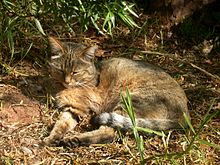

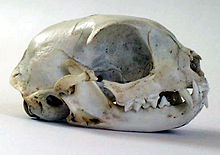
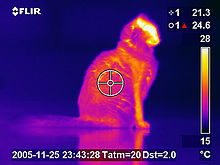




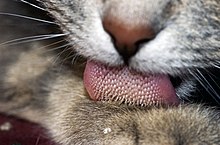
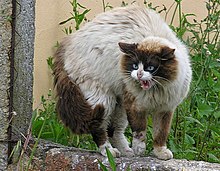


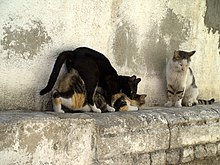


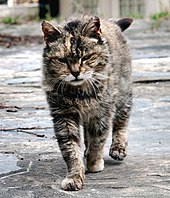
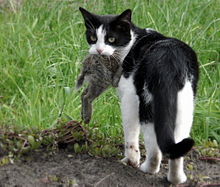


No comments:
Post a Comment